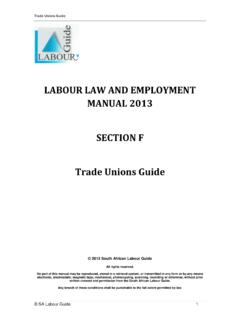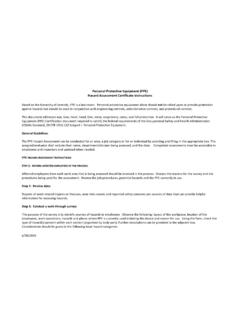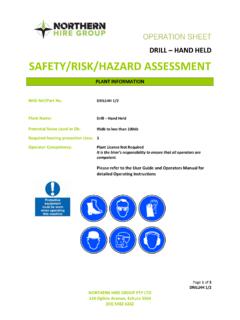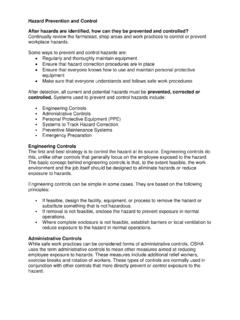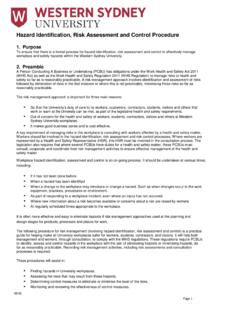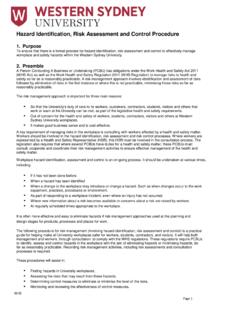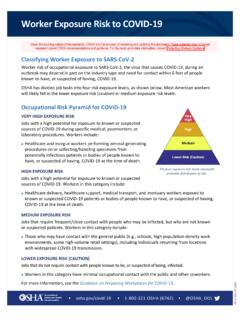Transcription of GUIDE TO HAZARD IDENTIFICATION AND RISK …
1 WIETA Code Principle Safe and Healthy Work Environment Date April 2016 Subject HAZARD IDENTIFICATION and Risk assessment GUIDE Internal Ref (a) Legal reference Section 8 of OHS Act, 1993 GUIDE TO HAZARD IDENTIFICATION AND RISK assessment (HIRA) 1. INTRODUCTION The most important legal duty imposed on employers by the Occupational Health and Safety Act, 1993 and incorporated Regulations is the one requiring of employers to conduct Risk Assessments (HIRA HAZARD IDENTIFICATION and Risk assessment ). Based on the outcome of the Risk Assessments decisions should be taken as to preventative measures to be implemented as to ensure a safe workplace is provided to employees, contractors and visitors to the workplace. 2. WHAT IS A HAZARD IDENTIFICATION AND RISK assessment HAZARD IDENTIFICATION and Risk assessment is a formal process involving the study of work activities, carried out as to: a.
2 Identifying hazards , which are the potential causes of harm. A HAZARD is defined as means a source of or exposure to danger . When assessing all hazards employers would be required to assess all tasks performed or machines / equipment used; b. Assessing the risks for each tasks evaluated. Risk is defined as means the probability that injury or damage will occur . When assessing the risk associated with the task performed the Risk Rating Sheet as attached and marked Annexure A could be used; c. Deciding on suitable measures to eliminate or control measures to be implemented. The Occupational Health and Safety Act, 1993 and incorporated Regulations regard the issuing of personal protective equipment as the last resort.
3 Employers should therefore first attempt to mitigate the hazards identified; WIETA Code Principle Safe and Healthy Work Environment Date April 2016 Subject HAZARD IDENTIFICATION and Risk assessment GUIDE Internal Ref (a) Legal reference Section 8 of OHS Act, 1993 d. Recording the information. Without any record of HIRA s conducted the employer would not be able to prove compliance. The format of the Risk assessment report is not prescribed, but the format as attached and marked Annexure B could be used; and e. Implementing control measures as to ensure that the workplace is as safe as what would be reasonable practicable. Reasonably Practicable is defined as means practicable having regard to: i. The severity and scope of the HAZARD or risk concerned; ii.
4 The state of knowledge reasonably available concerning that HAZARD or risk and of any means of removing or mitigating that HAZARD or risk; iii. The availability and suitability of means to remove or mitigate that HAZARD or risk; and iv. The cost of removing or mitigating that HAZARD or risk in relation to the benefits deriving therefrom 3. TYPES OF RISK ASSESSMENTS Risk assessments to be conducted could be divided into the following three types; a. Baseline Risk Assessments A Baseline Risk assessment would be conducted if no previous Risk assessment has been conducted. This Risk assessment report should reflect information on: i. All workplaces; ii. All activities or tasks performed; and iii. All machinery or tools used.
5 The frequency at which these Risk assessment reports should be reviewed is not prescribed. It is however common that annual reviews are required; b. Issue Based Risk Assessments These are Risk Assessments are typically conducted: WIETA Code Principle Safe and Healthy Work Environment Date April 2016 Subject HAZARD IDENTIFICATION and Risk assessment GUIDE Internal Ref (a) Legal reference Section 8 of OHS Act, 1993 i. After a new machine was purchased. The purpose of this assessment is to determine if the machine is safe and in compliance with legal and other requirements; ii. After an incident - During the incident investigation process weaknesses with internal policies or procedures could have been identified. The incident investigation may also show additional precautionary measures are required as to prevent a re-occurrence; and or iii.
6 When new legislation was promulgated New legislation may prescribe requirements which are currently not being complied with. Assessing the contents of the legislation will show these non-conformances and will allow employers to ensure compliance; c. Continues Based Risk Assessments Regular inspections conducted on equipment or machinery such as daily inspection of mobile plant could be regarded as continues based risk assessments. 4. HIRA TEAM Other than requiring of employers to conduct Risk Assessments the legislation does not prescribe by whom these assessments should be conducted. To ensure that comprehensive assessments are conducted it may be advisable involve staff from all levels and all workplaces.
7 5. WHERE TO START Following the following steps may assist employers in conducting a comprehensive HAZARD IDENTIFICATION and Risk assessment : a. List all Departments to be assessed; b. List all tasks / activities performed in the departments identified. This information could be recorded under the heading Task Performed in the HIRA Format attached and marked Annexure B; WIETA Code Principle Safe and Healthy Work Environment Date April 2016 Subject HAZARD IDENTIFICATION and Risk assessment GUIDE Internal Ref (a) Legal reference Section 8 of OHS Act, 1993 c. Additional to the tasks / activities performed also list other hazards which may have an effect on operations. Typical examples would be safety of the public, contractor management or legal requirements which the employer may have to be complied with.
8 This information should also be recorded under the heading Task Performed in the HIRA Format attached and marked Annexure B; d. For each item listed under the heading task performed the hazards associated with the activity to be determined. When working at heights it could be expected that persons may fall from heights; e. The HAZARD effect should give some indication on the extent of the injury or loss suffered. A person falling from a ladder may sustain serious injuries where as an injury sustained by members of the public could result in bad press and civil claims; f. Based on hazards identified and the HAZARD effect the risk rating associated with the task performed should be determined by means of the Risk Rating Sheet as per Annexure A.
9 The risk rating could be calculated based on the assumption that no control / precautionary measures have been implemented; g. Control / precautionary measures currently implemented or additional new measures needed should be recorded under the header Control Measures to be Implemented ; h. Considering the control measures implemented or to be implemented the process where the risk rating is determined should be repeated. In most cases there would be a reduction in risk; i. The columns Responsible Person and Target Date was merely included as to enable employers to assign duties and keep track of progress made. WIETA Code Principle Safe and Healthy Work Environment Date April 2016 Subject HAZARD IDENTIFICATION and Risk assessment GUIDE Internal Ref (a) Legal reference Section 8 of OHS Act, 1993 ANNEXURE A RISK RATING SHEET LIKELIHOOD (THE PROBABILITY OF AN INCIDENT WHEN THE EVENT DOES OCCUR) VALUE MIGHT AS WELL BE EXPECTED (HAPPENS OFTEN) QUITE POSSIBLE UNUSUAL, BUT QUITE POSSIBLE ONLY REMOTELY POSSIBLE (HAS HAPPEND SOMEWHERE) CONCEIVABLE, BUT VERY UNLIKELY (HASN T HAPPENED YET) PRACTICALLY IMPOSSIBLE (ONE IN A MILLION) VIRTUALLY IMPOSSIBLE (APPROACHES THE IMPOSSIBLE) 10 6 3 1 EXPOSURE (THE FREQUENCY OF OCCURRENCE OF THE EVENT) CONTINUOUS FREQUENT (DAILY) OCCASIONAL (WEEKLY)
10 UNUSUAL (MONTHLY) RARE (A FEW PER YEAR) VERY RARE (YEARLY) NO EXPOSURE 10 6 3 2 1 CONSEQUENCE CATASTROPHIC (MANY FATALITIES, OR DAMAGE OVER - R 10 000 000,00) DISASTER (A FEW FATALITIES, OR DAMAGE OVER - R1 000 000,00) VERY SERIOUS (ONE FATALITY, OR DAMAGE OVER R 100 000,00) SERIOUS (SERIOUS INJURY, PERMANENT DISABILITY, OR DAMAGE OVER- R 10 000,00) IMPORTANT (TEMPORARY DISABILITY, OR DAMAGE OVER- R 1 000,00) NOTICEABLE (MINOR FIRST AID, OR DAMAGE OVER - R 100,00) NEGLIGIBLE 100 40 15 7 3 1 RISK SCORE RISK CLASSIFICATION OVER 400 200- 400 70-200 20-70 UNDER 20 VERY HIGH RISK: CONSIDER DISCONTINUING OPERATION HIGH RISK: IMMIDIATE CORRECTION REQUIRED SUBSTANTIAL RISK: CORRECTION NEEDED POSSIBLE RISK: ATTENTION INDICATED ACCEPTABLE RISK WIETA Code Principle Safe and Healthy Work Environment Date April 2016 Subject HAZARD IDENTIFICATION and Risk assessment GUIDE Internal Ref (a) Legal reference Section 8 of OHS Act, 1993 ANNEXURE B HAZARD IDENTIFICATION AND RISK assessment DEPARTMENT Farm Workshop REFERENCE NO.


